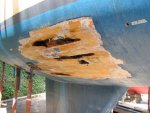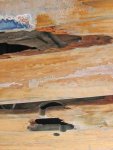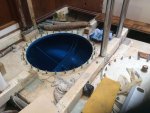KompetentKrew
Well-known member
I have quite the photo essay for you here. I've only owned my boat for about 3 years and, after discovering this, I thought "I'd better take this to the forum" and took lots of pics. Having done so, I'm not sure you need so many photos, but I'll add them to this post in case you're interested and to maximise the information I provide.
My boat is a Van De Stadt Caribbean 40, which was built in epoxy composite as a one-off by the Jachtbouw Johan Vels (which was pretty much Johan's back garden at that time) in the early 90's.
The freshwater tanks appear to be simply part of the hull, formed between one rib or bulkhead and the next with a lid on the top. Presumably they have been painted with epoxy on the inside?
Yesterday whilst cleaning I noticed this black stain on the plywood beneath the chart table:



I believe this indicates water intrusion into the plywood?
The layout of the boat is that next to the chart table is an armchair:

And underneath the armchair is a water tank.
I have circled some black staining that matches on this side of the ply:



Fortunately the tank is empty at the moment, so I put a couple of flashlights inside and waved my phone around taking photos.
From starboard to port, looking aft:








This seems like a crack where the top of the tank meets the sides, and that I can just paint it over with epoxy sealer?
I've never done this before and am mostly just going off a half-remembered conversation with a neighbour who has rust pin-holes in his boat's steel water tank. I believe he bought some kind of epoxy paint / sealer to fix these, and if it works on a steel tank then it must surely work on an epoxy boat, right!?
Does this seem like a sensible way forward? Do I need to use any particular brand of epoxy, to make it food safe? Or is my regular West System boat-fixin' epoxy adequate?
The last pic makes it look like the previous owner was in this tank doing the same thing before, but I don't see any evidence of a previous leak. Maybe is just the corner that Herr Vels finished up in when he was building the boat, and it's messy due to poor access.
I am grateful for any thoughts or comments you may be able to share.
My boat is a Van De Stadt Caribbean 40, which was built in epoxy composite as a one-off by the Jachtbouw Johan Vels (which was pretty much Johan's back garden at that time) in the early 90's.
The freshwater tanks appear to be simply part of the hull, formed between one rib or bulkhead and the next with a lid on the top. Presumably they have been painted with epoxy on the inside?
Yesterday whilst cleaning I noticed this black stain on the plywood beneath the chart table:



I believe this indicates water intrusion into the plywood?
The layout of the boat is that next to the chart table is an armchair:

And underneath the armchair is a water tank.
I have circled some black staining that matches on this side of the ply:



Fortunately the tank is empty at the moment, so I put a couple of flashlights inside and waved my phone around taking photos.
From starboard to port, looking aft:








This seems like a crack where the top of the tank meets the sides, and that I can just paint it over with epoxy sealer?
I've never done this before and am mostly just going off a half-remembered conversation with a neighbour who has rust pin-holes in his boat's steel water tank. I believe he bought some kind of epoxy paint / sealer to fix these, and if it works on a steel tank then it must surely work on an epoxy boat, right!?
Does this seem like a sensible way forward? Do I need to use any particular brand of epoxy, to make it food safe? Or is my regular West System boat-fixin' epoxy adequate?
The last pic makes it look like the previous owner was in this tank doing the same thing before, but I don't see any evidence of a previous leak. Maybe is just the corner that Herr Vels finished up in when he was building the boat, and it's messy due to poor access.
I am grateful for any thoughts or comments you may be able to share.






